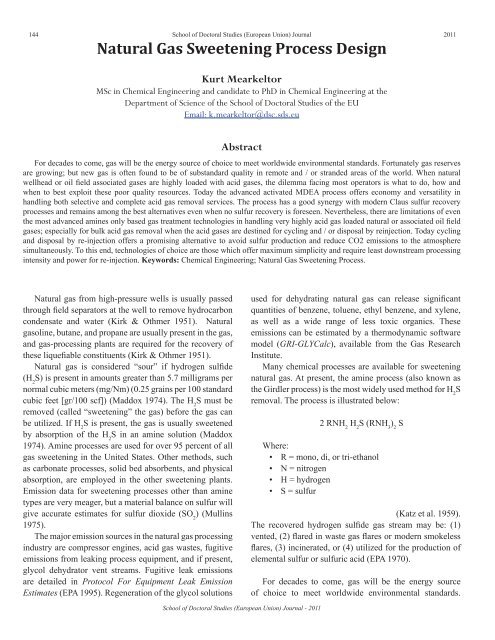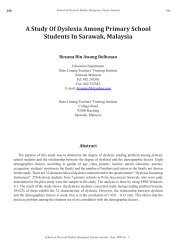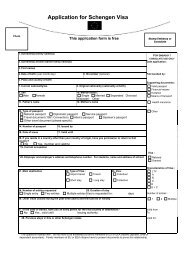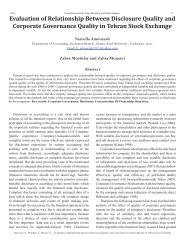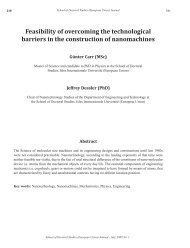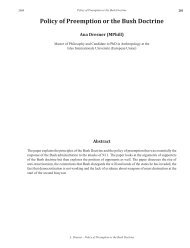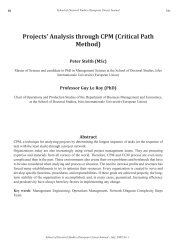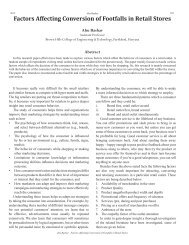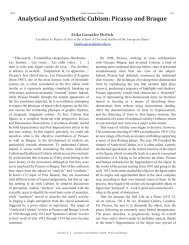Natural Gas Sweetening Process Design
Natural Gas Sweetening Process Design
Natural Gas Sweetening Process Design
You also want an ePaper? Increase the reach of your titles
YUMPU automatically turns print PDFs into web optimized ePapers that Google loves.
144 School of Doctoral Studies (European Union) Journal2011<strong>Natural</strong> <strong>Gas</strong> <strong>Sweetening</strong> <strong>Process</strong> <strong>Design</strong>Kurt MearkeltorMSc in Chemical Engineering and candidate to PhD in Chemical Engineering at theDepartment of Science of the School of Doctoral Studies of the EUEmail: k.mearkeltor@dsc.sds.euAbstractFor decades to come, gas will be the energy source of choice to meet worldwide environmental standards. Fortunately gas reservesare growing; but new gas is often found to be of substandard quality in remote and / or stranded areas of the world. When naturalwellhead or oil field associated gases are highly loaded with acid gases, the dilemma facing most operators is what to do, how andwhen to best exploit these poor quality resources. Today the advanced activated MDEA process offers economy and versatility inhandling both selective and complete acid gas removal services. The process has a good synergy with modern Claus sulfur recoveryprocesses and remains among the best alternatives even when no sulfur recovery is foreseen. Nevertheless, there are limitations of eventhe most advanced amines only based gas treatment technologies in handling very highly acid gas loaded natural or associated oil fieldgases; especially for bulk acid gas removal when the acid gases are destined for cycling and / or disposal by reinjection. Today cyclingand disposal by re-injection offers a promising alternative to avoid sulfur production and reduce CO2 emissions to the atmospheresimultaneously. To this end, technologies of choice are those which offer maximum simplicity and require least downstream processingintensity and power for re-injection. Keywords: Chemical Engineering; <strong>Natural</strong> <strong>Gas</strong> <strong>Sweetening</strong> <strong>Process</strong>.<strong>Natural</strong> gas from high-pressure wells is usually passedthrough field separators at the well to remove hydrocarboncondensate and water (Kirk & Othmer 1951). <strong>Natural</strong>gasoline, butane, and propane are usually present in the gas,and gas-processing plants are required for the recovery ofthese liquefiable constituents (Kirk & Othmer 1951).<strong>Natural</strong> gas is considered “sour” if hydrogen sulfide(H 2S) is present in amounts greater than 5.7 milligrams pernormal cubic meters (mg/Nm) (0.25 grains per 100 standardcubic feet [gr/100 scf]) (Maddox 1974). The H 2S must beremoved (called “sweetening” the gas) before the gas canbe utilized. If H 2S is present, the gas is usually sweetenedby absorption of the H 2S in an amine solution (Maddox1974). Amine processes are used for over 95 percent of allgas sweetening in the United States. Other methods, suchas carbonate processes, solid bed absorbents, and physicalabsorption, are employed in the other sweetening plants.Emission data for sweetening processes other than aminetypes are very meager, but a material balance on sulfur willgive accurate estimates for sulfur dioxide (SO 2) (Mullins1975).The major emission sources in the natural gas processingindustry are compressor engines, acid gas wastes, fugitiveemissions from leaking process equipment, and if present,glycol dehydrator vent streams. Fugitive leak emissionsare detailed in Protocol For Equipment Leak EmissionEstimates (EPA 1995). Regeneration of the glycol solutionsused for dehydrating natural gas can release significantquantities of benzene, toluene, ethyl benzene, and xylene,as well as a wide range of less toxic organics. Theseemissions can be estimated by a thermodynamic softwaremodel (GRI-GLYCalc), available from the <strong>Gas</strong> ResearchInstitute.Many chemical processes are available for sweeteningnatural gas. At present, the amine process (also known asthe Girdler process) is the most widely used method for H 2Sremoval. The process is illustrated below:2 RNH 2H 2S (RNH 3) 2SWhere:• R = mono, di, or tri-ethanol• N = nitrogen• H = hydrogen• S = sulfur(Katz et al. 1959).The recovered hydrogen sulfide gas stream may be: (1)vented, (2) flared in waste gas flares or modern smokelessflares, (3) incinerated, or (4) utilized for the production ofelemental sulfur or sulfuric acid (EPA 1970).For decades to come, gas will be the energy sourceof choice to meet worldwide environmental standards.School of Doctoral Studies (European Union) Journal - 2011
2011 <strong>Natural</strong> <strong>Gas</strong> <strong>Sweetening</strong> <strong>Process</strong> <strong>Design</strong>145Fortunately gas reserves are growing; but new gas isoften found to be of substandard quality in remote and /or stranded areas of the world. When natural wellhead oroil field associated gases are highly loaded with acid gases,the dilemma facing most operators is what to do, how andwhen to best exploit these poor quality resources.Today the advanced activated MDEA process offerseconomy and versatility in handling both selective andcomplete acid gas removal services. The process has a goodsynergy with modern Claus sulfur recovery processes andremains among the best alternatives even when no sulfurrecovery is foreseen (Blanc et al. 1981).Nevertheless, there are limitations of even the mostadvanced amines only based gas treatment technologies inhandling very highly acid gas loaded natural or associatedoil field gases; especially for bulk acid gas removal whenthe acid gases are destined for cycling and / or disposalby reinjection (Elgue, Peytavy, & Tournier-Lasserve1991). Today cycling and disposal by re-injection offers apromising alternative to avoid sulfur production and reduceCO 2emissions to the atmosphere simultaneously. To thisend, technologies of choice are those which offer maximumsimplicity and require least downstream processingintensity and power for re-injection (Elgue, Peytavy, &Tournier-Lasserve 1991).The behavior of CO 2and H 2S in combination withwater at high pressures and at temperatures within processoperating conditions can result in hydrate formation,liquid phases of the compounds, and large variations in theamount of absorbed water. Since similar experimental datafor mixtures of acid gases and water are not always readilyavailable in the public literature, it is necessary to relyon computer generated results for mixtures for designingcompression and injection facilities, which may not beentirely accurate (Royan & Wichert 1995).<strong>Natural</strong> gas reservoirs have always been associated withwater; thus, gas in the reservoir is water saturated. Whenthe gas is produced water is produced as well. Some ofthis water is produced water from the reservoir directly(Sharma & Campbell 1969). Other water produced with thegas is water of condensation formed because of changes intemperature and pressure during production.In the sweetening of natural gas, the removal ofhydrogen sulfide and carbon dioxide, aqueous solvents areusually used (Sharma & Campbell 1969). The sweetenedgas, with the H 2S and CO 2removed, is saturated with water.In addition, the acid gas byproduct of the sweetening is alsosaturated with water. Furthermore, water is an interestingproblem in the emerging technology for disposing of acidMearkeltor K., <strong>Natural</strong> <strong>Gas</strong> <strong>Sweetening</strong> <strong>Process</strong> <strong>Design</strong>gas by injecting into a suitable reservoir – acid gas injection(Sharma & Campbell 1969).In the transmission of natural gas further condensationof water is problematic. It can increase pressure drop inthe line and often leads to corrosion problems. Thus, watershould be removed from the natural gas before it is sold tothe pipeline company.For these reasons, the water content of natural gas andacid gas is an important engineering consideration (Sharma& Campbell 1969).Literature ReviewSour natural gas contains hydrogen sulfide (H 2S), whichhas to be removed to meet specifications for sales gas.Sour natural gas also contains carbon dioxide (CO 2). Theremoval of CO 2and H 2S, usually called acid gases, fromsour natural gas is generally accomplished by means ofa regenerative solvent. There are several amine solventsused for this purpose. Upon regeneration of the solvent, theacid gases are liberated, and are usually sent to a modifiedClaus plant, where the H 2S is converted to elemental sulfur(Canjar & Manning 1967). The acid gas stream to themodified Claus plant consists of H 2S, CO 2, water vapor andminor amounts of hydrocarbon gas.When the concentration of CO 2is considerably greaterthan the concentration of H 2S in the acid gas mixture,the Claus plant has difficulty in achieving a high sulfurrecovery. If the total sulfur rate is small, say less than 5 tonsper day, it may be more economical to recover the sulfur bysome other process. Such other processes, however, havemany drawbacks of their own (Canjar & Manning 1967).An alternative to recovering sulfur is to compress andreinject the acid gases into a suitable underground zone,in a manner similar to the disposal of produced water.An additional benefit of reinjecting the acid gases is theelimination of emission of sulfur compounds as well asCO 2to the atmosphere (Canjar & Manning 1967).Properties of H 2S and CO 2Upon removal of the acid gases H 2S and CO 2from thesour gas, an acid gas mixture is obtained at low pressurethat may also contain about 1 % to 3 % hydrocarbon gases,and which is saturated with water vapor (West 1948).This is the mixture that is compressed through 4 stagesof compression, from about 100 kPa (ga) to around 8 to10 MPa. In this process, water condenses, creating thepotential for corrosion and hydrate formation. In addition,
146 School of Doctoral Studies (European Union) Journal2011at such final compressor discharge pressures, the acid gasbecomes a liquid or a dense phase when cooled to ambienttemperatures (West 1948).While experimental results of studies of the physicalproperties of acid gas mixtures without hydrocarboncomponents are difficult to determine in the technicalliterature, the properties of pure CO 2and H 2S have beenexamined and reported (West 1948).Additionally, the properties of each of the acid gaseshave also been studied in the presence of water at elevatedpressures and temperatures.These results can be used as a guide to indicate how themixed acid gas streams would behave under the conditionsof pressure and temperature when compressed to theinjection pressure level.A brief review of the properties of the pure acid gasesand the CO 2- water and H 2S - water binaries is thereforeappropriate.Vapor / Liquid Properties of Pure CompoundsIn their pure state, CO 2and H 2S exhibit the normalvapor / liquid behavior with pressure and temperature. Athigher pressure and temperatures, the pure compoundsexist as liquid and vapor. Methane (CH 4) also exhibitsthis behavior, but at much lower temperatures. From thisit can be seen that CO 2and H 2S can readily be liquefiedat elevated pressures and at relatively high temperatures,whereas CH 4can be liquefied only at very low temperatures(Song & Kobayashi 1989).Mixtures of the acid gases are also readily liquefied atelevated pressures, but not mixtures containing substantialamounts of CH 4in their makeup.CO 2-Water and H 2S-Water MixturesWhen a mixture of CO 2or H 2S and water is subjected toelevated pressures, another phase, namely a solid hydratephase, is formed under certain conditions of temperature andelevated pressures. Hydrates can form at elevated pressuresand at fairly high temperatures with H 2S, and at somewhatlower temperatures with CO 2(Song & Kobayashi 1989).These pressures and temperatures are usually encounteredin acid gas injection processes.Water of Saturation for CO 2and H 2SThe ability of the pure compounds to hold water in thevapor phase is reduced as the pressure increases at about2.7 MPa for H 2S and up to about 6 MPa for CO 2. Whenpressures are raised above these levels, the capacity of H 2Sand CO 2to hold water in solution increases substantially, asboth compounds have a higher water absorption capacityin the liquid phase or dense phase as compared with theirvapor phases (Song & Kobayashi 1989). A small amount ofmethane reduces substantially the water absorption abilityof CO 2at elevated pressure.Other water content data at various temperatures andpressures for CO 2and H 2S are illustrated in Figures 20-4 to20-7 of the GPSA Engineering Data Book, on page 20-5 ofthe 1994 edition.Acid <strong>Gas</strong> MixturesIt is well known in the natural gas industry that raw sournatural gas mixtures present increased problems as comparedto sweet natural gas in mainly two areas: increased potentialfor corrosion and increased propensity for the formation ofhydrates at elevated pressures. It is therefore assumed thatacid gases with little or no hydrocarbon content will furtherexacerbate these two problems. In actual fact, this may notbe the case.Problem of CorrosionCorrosion of low alloy steel by sour gas occurs mainlyin the presence of a liquid aqueous phase. The corrosionmanifests itself as general metal loss corrosion or pittingcorrosion (Selleck et al. 1952). When these occur, atomichydrogen is generated, which has the ability to penetratesteel. This can lead to hydrogen induced cracking, blisteringor sulfide stress-cracking, resulting in sudden failures ofthe confining pipes or vessels. By following the NACEMR0175 standard in materials selection and adhering torecommended construction practices, such failures canusually be avoided.By dehydrating sour gas, corrosion by H 2S or CO 2iseffectively eliminated. Similarly, the potential for corrosionby acid gas can also be controlled by dehydration.Problem of HydratesThe hydrate forming temperature at any pressure of asour natural gas increases with increasing content of H 2S.The opposite is the case with CO 2. For sour natural gaseswith low concentrations of H 2S, the concentration of CO 2is usually much greater than the concentration of H 2S(Wiebe & Gaddy 1941). Thus the acid gas mixture, uponSchool of Doctoral Studies (European Union) Journal - 2011
148 School of Doctoral Studies (European Union) Journal2011cooled below 20°C, the mixture will be in the liquid phase,provided the methane content is no greater than one or twopercent (Wiebe & Gaddy 1941). The density of a liquidacid gas mixture at such conditions will have a density ofabout 70 to 80 % of the density of water. Thus the density ofthe acid gas stream in the liquid state will aid the injectionpressure into the reservoir. Also, the rate of injection will begenerally low, less than 1 Bbl/min. One Bbl/min. of liquidCO 2injection amounts to about 100 10 3m 3/d or 3.6 MMscf/dof gaseous CO 2at standard pressure and temperature. Manyzones have a pressure near the hydrostatic head of water(Selleck et al. 1952).Thus the wellhead injection pressure would generallybe in the order of 6000 to 9000 kPa, and would dependlargely on the injectivity of the reservoir as well as reservoirpressure and depth. A four – stage compressor, can achievethe pressure of 6000 to 9000 kPa.Table 1 shows the typical operating pressures for a four– stage compressor at a compression ratio of 3 betweenstages, and Figure 5 presents the variation in temperaturebetween stages for an acid gas mixture containing 1%CH 4, 49% C 2and 50% H 2S. The hydrate temperature withincreasing pressure is shown with dashes.Table 1. Typical Interstage Pressures for a Four-StageCompressorStage No. Suction P., kPa (abs.) Discharge P., kPa (abs.)1 150 4552 385 11603 1090 32704 3200 9600(Song & Kobayashi 1984)The total horsepower requirement in the above example isabout 7.94 kW per 10 3m 3/d (300 HP per Mmscf/d).Cooler After Final Compression StageIf the acid gas is to be cooled after the final stage ofcompression so that it is converted into a liquid or densephase, the final cooler section has to be designed to removethe equivalent of the latent heat of condensation of the acidgas. In Figure 5, for example, the heat removed duringcooling after the fourth stage is about four times thatremoved after the third stage.MetallurgyThe compressor cylinders will compress gas that is at itswater dew point on the suction side, and under-saturated inthe compressor cylinder and on the discharge side, due tothe temperature rise as a result of compression. Thus carbonsteel meeting NACE MR0175 standard requirements for sourgas should be installed as a minimum. The line to the aerialcooler can be carbon steel meeting the NACE standard. Inthe inter-stage coolers, water will condense, and could posea corrosion problem. Downstream of the coolers, the linesto the inter-stage scrubbers and the scrubbers themselveswill be exposed to the corrosive acid gas and condensedwater mixture. Carbon steel meeting NACE specificationsfor sour gas, coupled with an appropriate corrosioninhibition program, should be all that is required to handlethese corrosive fluids.After the third stage of compression, the pressure willbe in the order of about 3000 to 4000 kPa. This is the finalstage at which water will condense in the cooler. Uponboosting the pressure substantially above 6000 kPa, theacid gas mixture can hold more water in solution than at theprevious separation stage. Thus upon cooling after the fourthcompression stage, there should theoretically be no waterof condensation dropping out (Song & Kobayashi 1989).If this is so, then there would be no need to dehydrate thegas, and the downstream facilities could be constructed outof carbon steel meeting NACE specifications, which wouldsave the gas industry a lot of money. This aspect of acid gasphase behavior should be experimentally investigated.If dehydration is chosen to ensure that no waterof condensation drops out at the high pressures, thedehydration should take place after the second or thirdstage of compression. When dehydration occurs after thesecond stage, the pressure is relatively low, but the acidgas mixture contains more water than after the third stagecompression and cooling. With dehydration occurring afterthe third stage, the operating pressure of the dehydratorwould be about 3 times the pressure after the second stageof compression. This would require less glycol circulation,smaller vessel diameter, but the amount of acid gasesabsorbed per gallon of glycol circulated would be higher.However, glycol circulation would need to be about onehalf of the required circulation for dehydration after thesecond stage of compression, since there is less water toremove from the acid gas stream at the higher pressure(Selleck et al. 1952).School of Doctoral Studies (European Union) Journal - 2011
2011 <strong>Natural</strong> <strong>Gas</strong> <strong>Sweetening</strong> <strong>Process</strong> <strong>Design</strong>149In general, the selected metallurgy would dependon whether the gas is dehydrated or not. Stainless steelequipment includes the suction scrubbers, pulsation bottles,interconnecting piping and cooler tubes. The metallurgyof valves and instrumentation such as block valves, dumpvalves, PSV’s, gauge glasses, etc., should generally matchthe material of the vessel and piping.Compressor cylinder material can be carbon steel.Compressor suction and discharge valves should bestainless steel. The piston rod should be stainless steel,and may be coated with a tungsten carbide overlay havinga maximum hardness of RC22. Distance pieces can besingle compartment with a vacuum pump, or a two-piececompartment with a sweet gas purge system (Royan &Wichert 1995).Because of the low suction pressure in the 1st stagesuction scrubber, any liquids must be dumped to anatmospheric tank, or handled by a pump. Any liquidscondensing in the remaining suction scrubbers are usuallydumped to a sour water treatment and disposal system.Ideally, these liquids should be returned to the aminesystem, to save on make – up water. However, due topotential contamination with compressor oil, it is safest todiscard the water that condenses in the suction scrubbers(Royan & Wichert 1995).Compressor Units can be equipped with separatecylinder lubrication and flushing oil systems so that lubeoils and corrosion inhibitors can be injected separately.Corrosion allowance in piping generally should be 3 mmin carbon steel materials and 1.5 mm in stainless steelmaterials (Royan & Wichert 1995).Acid <strong>Gas</strong> DehydrationWhether or not acid gas dehydration is necessary isdebatable. As mentioned above, under certain conditionsof pressure and temperature, no water of condensationwould occur after the final stage of compression (Canjar &Manning 1967).If dehydration is installed, then it should be part of theprocess at pressures of minimum water content in the acidgas stream. At a temperature of about 35 °C after cooling, theoptimum pressure range is 3000 to 5000 kPa, depending onthe acid gas composition. This is the pressure range in whichacid gas mixtures should exhibit a minimum equilibriumwater content at the process operating temperature range(Song & Kobayashi 1984).The dehydration equipment would be a normal glycolunit, with a minimum of six trays, using triethylene glycol.In sales gas dehydration, the water content has to be reducedto about 65 mg/m3 (4 Ibs/MM). Since the objective inacid gas dehydration is simply the avoidance of a liquidwater phase, the amount of water left in the acid gas can besubstantially higher than 65 mg/m3. A safe water contentwould be about 500 to 700 mg/m3 (0.5 to 0.7 kg/103m3)(Song & Kobayashi 1984). Thus, the dehydration facilitiesfor acid gas could be operated more economically than forsales gas dehydration.One of the problems with dehydration of gas in generaland with acid gas in particular is the disposal of the reboileroff-gases (Wiebe & Gaddy 1941). There is considerableenvironmental concern with venting these off - gases intothe air. In acid gas dehydration, these off-gases have to becollected and incinerated or cooled and recompressed intothe acid gas steam.Acid <strong>Gas</strong> Injection FacilitiesThe acid gas injection facilities beyond the final stage ofcompression and cooling consist of an injection line, wellsitecontrol facilities and the injection well.The Disposal LineMearkeltor K., <strong>Natural</strong> <strong>Gas</strong> <strong>Sweetening</strong> <strong>Process</strong> <strong>Design</strong>Selection of the type of pipeline material for the acidgas injection line between the plant and the injection wellis generally related to whether or not the acid gas has beendehydrated. For dehydrated gas, sour service carbon steelmaterials can be used, such as CSA-Z662 Grade 359 Cat.II sour service material. The addition of corrosion inhibitorshould be considered.For non-dehydrated acid gas, the line can be of carbonsteel with an internal epoxy coating, or a polyethylene liner(EPA 1995).Another pipeline material can be 316L stainless steel.One of the key considerations is the length of the line.Stainless steel is more expensive, and if the cost of the lineexceeds the cost of a dehydration unit, then it may be moreeconomical-to dehydrate the acid gas stream. The proposedpipeline should be fully evaluated with the vendor ofthe materials to ensure compatibility with anticipatedprocess conditions of pressure, temperature and acid gascomposition (EPA 1995).The line diameter should be sized for liquid phase fluidsif the acid gas mixture contains no more than about 1 %hydrocarbons (EPA 1995). This means that the injectionrates would be quite low in terms of liquid quantities.
2011 <strong>Natural</strong> <strong>Gas</strong> <strong>Sweetening</strong> <strong>Process</strong> <strong>Design</strong>151The drilling and completion costs are largely dependenton the depth of the horizon. Table 2 shows the cost estimatesfor drilling acid gas injection wells to 1500 and 2500 m inAlberta, and completing them with 73 mm J55 EUE tubingthat is internally coated for corrosion protection.Table 2. Cost Estimate To Drill And Complete Acid <strong>Gas</strong>Disposal Well In AlbertaDepth, m Drill & Case Complete Total Cost1,500 $350,000 $150,000 $500,0002,500 $550,000 $250,000 $800,000Cost Comparisons with Small Scale SulfurRecovery OptionsIn a companion paper, the various options for small-scalesulfur recovery are discussed (Royan & Wichert 1995).The capital cost of any of sulfur recovery process depends,of course, on many variables, such as the plant designthroughput, composition, location, etc. The comparativecosts can best be illustrated by an example:Estimate the capital cost of the sweetening facilitiesand the various sulfur recovery and disposal facilitiesfor a sour gas plant designed to treat 500 10 3m 3/d ofgas with 2.0 % CO 2and 0.44 % H 2S.(EPA 1995).The completion would include a downhole cheek valve,for safely reasons in case of surface equipment failure.A downhole packer would protect the casing and a noncorrosivefluid, such as diesel fuel containing corrosioninhibitor, in the annulus between the casing and tubing, asis normally required for water injection or disposal wells.(Royan & Wichert 1995)The total sulfur content in the inlet gas stream in the aboveexample is 2.98 t/d. The acid gas stream will contain 18 %H 2S, unless some CO 2is left in the sweet gas by the chosensolvent. For the purpose of this example it is assumed thatall of the CO 2will be extracted. The capital cost estimatefor the equipment, without installation in the field, is shownin Table 3.Table 3. Estimate of Capital Cost of Various Sulphur Recovery <strong>Process</strong>es (Thousands of Dollars)<strong>Process</strong> Equipment Two-stage Claus One-stage Selectox LO-CAT II SulFerox Acid <strong>Gas</strong> Injection<strong>Sweetening</strong> 650 650 650 650 650Sulfur recovery:Facilities 1,000 1,000 2,400 1,800 0Catalyst 6 40 0 0 0S Filter/Melt 0 0 300 300 0Solvent 75 75 300 300 0Incin. /Stack 150 150 0 0 0Acid gas Injection:Acid gas compr. 0 0 0 0 650Acif gas line (316SS) 0 0 0 0 40Injection well 0 0 0 0 700Royalties 0 100 150 200 0Estimated Total 1,881 2,015 3,800 2,850 2,040Note: Estimated capital costs are for skid mounted equipment f.o.b. Calgary shop.(Royan & Wichert 1995)The capital cost changes somewhat with the total plantthroughput and the H 2S content. If in the above examplethe total sour gas inlet rate to the plant were 900 10 3m 3/d,having a CO 2content of 4 % and a H 2S content of 0.12%,the capital cost estimate would be as per Table 4. In thiscase the sulfur inlet rate to the plant is 1.46 t/d, with the H 2Sconcentration in the acid gas stream being 2.91 % (Royan& Wichert 1995).To employ the modified Claus process in the secondexample requires that a process be added between thesweetening step and the Claus plant to enrich the acid gassufficiently in H 2S so that a modified Claus unit will operatesatisfactorily.Mearkeltor K., <strong>Natural</strong> <strong>Gas</strong> <strong>Sweetening</strong> <strong>Process</strong> <strong>Design</strong>
152 School of Doctoral Studies (European Union) Journal2011Table 4. Estimate of Capital Cost Of Various Sulphur Recovery <strong>Process</strong>es (Thousands Of Dollars)<strong>Process</strong> Equipment Two-stage Claus One-stage Selectox LO-CAT II SulFerox Acid <strong>Gas</strong> Injection<strong>Sweetening</strong> 1,250 1,250 1,250 350 1,250Sulfur recovery: (See note 2)Acid gas enr. 750 0 0 0 0Facilities 750 800 1,900 1,550 0Catalyst 5 20 0 0 0S Filter/Melt 0 0 300 300 0Int. Chem. Chg. 225 75 250 250 0Incin. /Stack 150 150 0 0 0Acid gas Injection:Acid gas compr. 0 0 0 0 1,000Acif gas line (316SS) 0 0 0 0 40Injection well 0 0 0 0 700Royalties 200 100 150 200 0Estimated Total 3,300 2,395 3,850 2,650 2,990Note 1. Estimated capital costs are for skid mounted equipment f.o.b. Calgary shopNote 2. 4% CO 2left in sales gas(Royan & Wichert 1995)Each of the sulfur recovery processes would release theCO2 to the atmosphere, amounting to 6,800 and 24,500tons annually for the two cases, respectively.Operating CostsOperating cost estimates for all processes are given inTable 5 and include of the following items:• Utilities (electricity, fuel gas, water)• Chemicals (catalyst, chelates, iron oxide ions, pHcontrol, corrosion inhibitor)• Maintenance• Operator timeTable 5. Estimate Of Annual Operating Cost Of Various Sulphur Recovery <strong>Process</strong>es (Thousands Of Dollars, For Example 1 Above)Cost Item Two-stageClaus One-stage Selectox LO-CAT II SulFerox Acid <strong>Gas</strong> InjectionElectr. Power 76.3 95.5 78.4 104.0 153.3Fuel gas 7.50 75.0 75.0 0 75.0Catalyst 2.0 13.0 0 0 0Chemicals 25.0 25.0 320.0 350.0 25.0Labor, Op/Mnt 150.0 150.0 250.0 250.0 200.0Sulfur Disp. 0 0 50.0 50.0 0Estimated Total 328.3 358.5 773.4 754.0 453.3$ Per ton of S 301 330 711 693 416Assumptions going into these cost estimates:• Catalyst change-out: once per 3 years• Electricity: 10 c/kWh• Fuel gas: $1.50/GJ• Chemicals: routine consumption(Royan & Wichert 1995)The above cost estimates are for the first example, andinclude operator time. The costs for sulfur recovery schemeswill not very that much between the two examples, as theoverall amount of sulfur recovered is not that large to beginSchool of Doctoral Studies (European Union) Journal - 2011
2011 <strong>Natural</strong> <strong>Gas</strong> <strong>Sweetening</strong> <strong>Process</strong> <strong>Design</strong>153with. Regarding acid gas compression, however, the costswould be higher in the second example by about $155thousand in light of more compression for the higher acidgas rate.Optimum Acid <strong>Gas</strong> Injection SchemeIn light of the above discussions, it is possible to projectwhat a minimum acid gas compression and injectionscheme would include – as discussed below:Injection WellThe injection well should be drilled specifically for thepurpose of acid gas injection. It should be located nearthe plant, so that the injection line would be short, andit would be within the Emergency Planning Zone of theplant. This would minimize the cost of the pipeline. Theselected zone should be an aquifer of large extent, withgood permeability. This means that the gas would not bereproduced, as would potentially be the case if the gas wereinjected into a hydrocarbon-bearing zone (EPA 1995).The depth of the well should be between 1000 and 1500m, so that the injection pressure did not have to be above8000 kPa. This pressure level would ensure that the acidgas mixture is in the liquid phase upon final cooling, whichwould aid with the injection into the zone.The well could be completed with 114.3 mm casingstring and a 60.3 mm OD J-55 tubing string, as the liquidinjection rate would in all likelihood be less than 100 L/min(27 US gal/min), thereby saving on drilling and completioncosts. A subsurface check valve should be installed in thetubing (EPA 1995).Any water that might drop out would be minimal, wouldform a hydrate, and would immediately be reabsorbed uponstartup of injection. A small, high pressure, sweet gas lineshould be included from the plant to the well, for reasonsexplained above.Water RemovalIt is evident that free water cannot be tolerated at theinjection pressure levels of the acid gas mixture, becausehydrates could form. There is a minimum water of saturationcontent at certain pressure and temperature conditions.By taking advantage of this situation, it may be possibleto lower the water content sufficiently by cooling the acidgas stream, so that dehydration would not be required (EPA1995).A more economical method than dehydration wouldbe to cool the gas stream to about 30 or 35 °C after thethird stage of compression. The cooling could be done withan aerial cooler to about 3 or 4 degrees above the hydratetemperature for the particular acid gas composition. Thiswould condense most of the water while the acid gas mixtureis in the vapor phase (EPA 1995). Upon compression andcooling after the fourth stage of compression, the acid gasstream would be in the liquid or dense phase. The waterof saturation at the temperatures in the short line to theinjection well would always be higher than the water contentat the final separation stage. It is assumed in this examplethat the hydrocarbon content of the acid gas mixture is lessthan about 3 %. Higher concentrations of C 1+will adverselyaffect this acid gas-water relationship (EPA 1995).Acid <strong>Gas</strong> CompressionThe Injection LineSince the well would be located near the plant, theinjection line would be relatively short. A 316L stainlesssteel line, 50 mm in diameter, would likely be the bestchoice. This line would need to be externally coated forcorrosion protection, but would not need to be insulated(EPA 1995).Under normal operating conditions, the acid gas liquidor dense stream would not cool sufficiently to have waterdrop out to cause problems. If the line were shut down forsome time, the contents of the line would cool down toground temperature at burial depth, which would generallynot be below 0 °C (EPA 1995).An estimate has to be made of the final pressure towhich the acid gas stream has to be compressed. Thisdepends mainly on the formation pressure, which dependson the well depth in undisturbed reservoirs. Other factorsinfluencing the injection pressure are the permeability ofthe zone, the thickness of the zone and the rate of injection.Assuming that the necessary pressure is between 6 MPaand 10 MPa, a four-stage compressor should be used (EPA1995).Concerning the metallurgy of the compressor, thesuction scrubbers, the suction and discharge lines and thecoolers, some items may need to be stainless steel, but withresearch in the area of water content, some of the linescould probably be constructed with carbon steel meetingNACE specifications for sour gas applications.Mearkeltor K., <strong>Natural</strong> <strong>Gas</strong> <strong>Sweetening</strong> <strong>Process</strong> <strong>Design</strong>
2011 <strong>Natural</strong> <strong>Gas</strong> <strong>Sweetening</strong> <strong>Process</strong> <strong>Design</strong>155A0 A1 A2 A3 A4 s2-butanone (1)+1-chloropentane (2)V E, cm 3.mol -12,64654 0,13115 -0,00177 0,06722 0,00270R E, cm 3.mol -10,36011 -0,03642 -0,00717 0,00785 0,001002-butanone (1)+1,3-dichloropropane (2)V E, cm 3.mol -1-0,49936 0,98856 1,31123 0,25639 0,00234R E, cm 3.mol -10,16256 0,19454 0,11474 0,09188 -0,15178 0,000692-butanone (1)+1,4-dichlorobutane (2)V E, cm 3.mol -1-1,11593 0,72989 0,05418 0,00280R E, cm 3.mol -10,28129 0,42182 -0,46736 0,02022 -0,10627 0,000742-butanone (1)+1,1,1-trichloroethane (2)V E, cm 3.mol -10,35307 0,62942 0,15189 0,04568 0,00009R E, cm 3.mol -10,12084 0,14019 0,02597 0,000132-butanone (1)+1,1,2,2-tetrachloroethane (2)V E, cm 3.mol -1-4,40442 -0,26605 -0,26976 -0,09947 0,00032R E, cm 3.mol -1-0,13382 0,34352 -0,05271 0,000170,800,400,00-0,40-0,80excess volume molar, cm1,200,00 0,20 0,40 0,60 0,80 0,100X 1• 2-butanone (1)+1-chloropentane (2)• 2-butanone (1)+1,4-dicholorobutane (2)• 2-butanone (1)+1,3-dichloropropane (2)• 2-butanone (1)+1,1,1-trichloroethane (2)• 2-butanone (1)+1,1,2,2-tetrachloroethane (2)0,120,080,04.molRE,cm3-0,04-0,080,00 0,20 0,40 0,60 0,80 1,00X 1• 2-butanone (1)+1-chloropentane (2)• 2-butanone (1)+1,4-dichlorobutane (2)• 2-butanone (1)+1,3-dichloropropane (2)• 2-butanone (1)+1,1,1-trichloroethane (2)• 2-butanone (1)+1,1,2,2-tetrachloroethane (2)References(Tasic et al. 1992)Blanc, C., Elgue, J., & Lallemand, F. “MDEA processselects H2S”. Hydrocarbon <strong>Process</strong>ing, 1981.Canjar, L. & Manning, F. Thermodynamic Propertiesand Reduced Correlations for <strong>Gas</strong>es, GulfPublishing Company, 1967.Elgue, J., Peytavy, J., & Tournier-Lasserve J. “Recentindustrial developments in natural gas sweeteningby MDEA”. Paper presented at the 18th World <strong>Gas</strong>Conference in Berlin, 1991.<strong>Gas</strong> Research Institute. Thermodynamic SoftwareModel (GRI – GLYCalc).GPSA. GPSA Engineering Data Book, 1994 Edition.1994: 20-25.Katz, D., et al. Handbook Of <strong>Natural</strong> <strong>Gas</strong> Engineering.New York: McGraw-Hill Book Company, 1959.Kirk, R. & Othmer, D. (eds.). Encyclopedia OfChemical Technology, Volume 7. New York:Interscience Encyclopedia, Inc., 1951.Maddox, R. <strong>Gas</strong> And Liquid <strong>Sweetening</strong>, 2nd Edition.Norman, OK: Campbell Petroleum Series, 1974.Mullins, B. et al. Atmospheric Emissions Survey OfThe Sour <strong>Gas</strong> <strong>Process</strong>ing Industry, EPA-450/3-75-076, U. S. Environmental Protection Agency,Research Triangle Park, NC: 1975.NACE MR0175. Sour Service. (2002) 08 February2004. Mearkeltor K., <strong>Natural</strong> <strong>Gas</strong> <strong>Sweetening</strong> <strong>Process</strong> <strong>Design</strong>
156 School of Doctoral Studies (European Union) Journal2011Royan, T. & Wichert, E., Options for Small ScaleSulphur Recovery. Paper presented at the CGPAMeeting. Calgary: 1995.Selleck, F. et al. “Phase Behaviour in the HydrogenSulfide – Water System”. Industrial and EngineeringChemistry 44 1952: 2219-26.Sharma, S. & Campbell, J. “Predict <strong>Natural</strong>-gasWater Content with Total <strong>Gas</strong> Usage”. Oil and <strong>Gas</strong>Journal. 1969.Song, K. & Kobayashi, R. Water Content Values of aCO2 – 5.32 Mol Percent Methane Mixture, ResearchReport RR-20, <strong>Gas</strong> <strong>Process</strong>ors Association, Tulsa:1989.---.The Water Content of CO2– Rich Fluids inEquilibrium with Liquid Water or Hydrates, researchReport RR-80, <strong>Gas</strong> <strong>Process</strong>ors Association, Tulsa:1984.Tasic, A. et al. Journal of Chemical Engineering Data37 1992.U.S. Environmental Protection Agency. ProtocolFor Equipment Leak Emission Estimates, EPA-453/R-95-017: 1995---.Control Techniques For Hydrocarbon And OrganicSolvent Emissions From Stationary Sources, AP-68. Research Triangle Park, NC: 1970.West, J. “Thermodynamic Properties of HydrogenSulfide”. Chemical Engineering Progress 44 1948:287-92.Wiebe, R. & Gaddy, V. “Vapor Phase compositionof Carbon Dioxide – Water Mixtures at VariousTemps. And Pres. to 700 Atmospheres”. Journal ofAmerican Chemical Society 1941: 475-77.School of Doctoral Studies (European Union) Journal - 2011


